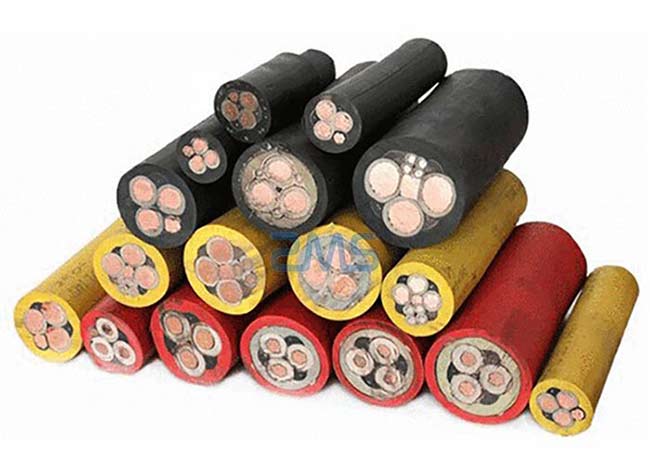Anche il materiale del cavo gioca un ruolo decisivo nella qualità del cavo. Nel passato, cavi di plastica sono stati utilizzati più spesso, ma gradualmente cavi di gomma iniziò a sostituire i cavi di plastica. Così è perché il cavo in gomma deve essere il migliore. Qui lascia che l'editore della società di cavi ZMS spieghi la differenza tra gomma e plastica.

Ampiamente parlando, La gomma è una specie di plastica e la plastica include gomma.
La differenza più essenziale tra plastica e gomma è che si deforma plasticamente quando la plastica subisce una deformazione, Mentre la gomma è una deformazione elastica. In altre parole, Non è facile ripristinare lo stato originale di plastica dopo la deformazione, mentre la gomma è relativamente molto più facile.
L'elasticità della plastica è molto piccola, di solito meno di 100%, mentre la gomma può raggiungere 1000% o più. La maggior parte del processo di modanatura della plastica viene completato quando viene completato anche il processo di stampaggio del prodotto. Mentre il processo di stampaggio in gomma viene completato dopo la necessità del processo di vulcanizzazione.
La plastica e la gomma appartengono agli stessi materiali polimerici, principalmente composti da due atomi di carbonio e idrogeno, e alcuni contengono una piccola quantità di ossigeno, azoto, cloro, silicio, fluoro, zolfo, e altri atomi.
Le sue proprietà sono speciali e i suoi usi sono speciali. A temperatura ambiente, La plastica è solida, difficile, e non può essere allungato e deformato. Mentre la gomma non è difficile, o elastico, può essere allungato per diventare più lungo, smettila di allungare, e può tornare al suo stato originale. Ciò è dovuto alla differenza nella loro struttura molecolare.
Un'altra differenza è che la plastica può essere riciclata e riutilizzata molte volte, mentre la gomma non può essere riciclata direttamente, ma solo dopo l'elaborazione in gomma riciclata, e poi disponibile. La forma di plastica a over 100 a 200 gradi è simile alla forma di gomma a 60 a 100 gradi. Le materie plastiche non includono la gomma.
Introduzione al filo di gomma e al cavo clorosolfonate in polietilene applicazioni in gomma
Tipi
Il polietilene clorosolfonato è un derivato del polietilene. A seconda del contenuto di cloro e del peso molecolare in polietilene, La gomma in polietilene clorosolfonata ha polietilene clorosolfonato 20, polietilene clorosolfonato 30, polietilene clorosolfonato 40, polietilene clorosolfonato 45. il industria dei cavi e dei cavi generalmente usa il polietilene clorosolfonato 20, e polietilene clorosolfonato 40.
Caratteristiche
1. Avere buone proprietà fisiche e meccaniche.
2. Ha una buona resistenza al calore e può essere utilizzato continuamente a una temperatura di 120 ℃.
3. Eccellente resistenza all'ozono, Resistenza alla luce del sole, e resistenza all'invecchiamento atmosferico, Esposizione all'aperto per sei anni senza crack.
4. Buona resistenza alla fiamma, secondo solo alla gomma fluoro e al neoprene.
5. Ottima resistenza chimica.
6. Buona resistenza all'olio.
7. Buona resistenza alla corona e alle radiazioni.
8. Ha buone prestazioni del processo e può essere utilizzato con altre gomme.
Gli svantaggi della gomma polietilene clorosolfonati sono una deformazione di compressione leggermente maggiore e scarse prestazioni a bassa temperatura. Ma a causa dei suoi vantaggi, È una gomma molto promettente in gomma sintetica.
Polietilene clorosolfonato 40 è spesso usato per l'isolamento e la guaina, e polietilene clorosolfonato 20 può essere utilizzato per l'isolamento del filo a bassa tensione.
Filo di gomma e cavo con gomma siliconica
Prima di tutto, La gomma silicone è una gomma speciale, speciale nella sua resistenza al calore è molto buono.
La resistenza al calore è perché la sua catena molecolare è composta da (-E-o-) legami, energia di legame al silicio-ossigeno rispetto al legame con il carbonio molto più grande 456>348KJ/mol, e SI è un elemento non combustibile, con le caratteristiche dei materiali inorganici, Quindi la resistenza al calore è alta. La gomma silicone ha morbidezza, può resistere all'ozono, corona, e fiamma, ha buone prestazioni di isolamento, resistenza ad alta e bassa temperatura (-60-200 ℃), e la resistenza alla corona e la resistenza all'arco sono molto buone, è la produzione di materiali cavi e cavi e affidabili.
In secondo luogo, Resistenza a freddo, accoppiato con la resistenza al calore è dire che la gamma di temperature di lavoro in gomma siliconica è molto ampia, Lo stesso di sopra è anche il motivo è che l'energia del legame è grande.
Ci sono anche una buona resistenza all'olio, Resistenza al solvente, Resistenza alle radiazioni e resistenza alla fiamma, e buona resistenza alla muffa; Inoltre, insapore e non tossico, Nessun effetto avverso sulla salute umana quando utilizzato.
Ma ha anche svantaggi: resistenza alla trazione, lacerare la forza, e la resistenza all'abrasione a temperatura ambiente è molto più bassa della gomma naturale e di altre gomma sintetica, Scarsa acido e resistenza alcali, e costoso, scarse prestazioni di elaborazione.
Gomma in silicone in vinile indipendentemente dalla procedura, Proprietà fisiche e meccaniche, resistenza alle alte temperature, e la deformazione permanente di compressione nella gomma siliconica è relativamente buona e ha più applicazioni nel settore dei cavi.
Queste sono le differenze, i vantaggi e gli svantaggi Cavi di gomma e cavi di plastica in vari aspetti. Non importa quale cavo viene utilizzato, Finché è adatto, Deve essere bene da usare. ZMS Cable è in attività da più di dieci anni, Portare cavi migliori e più professionali ai nostri clienti, con audit di qualificazione manuale rigoroso, affidabile.


